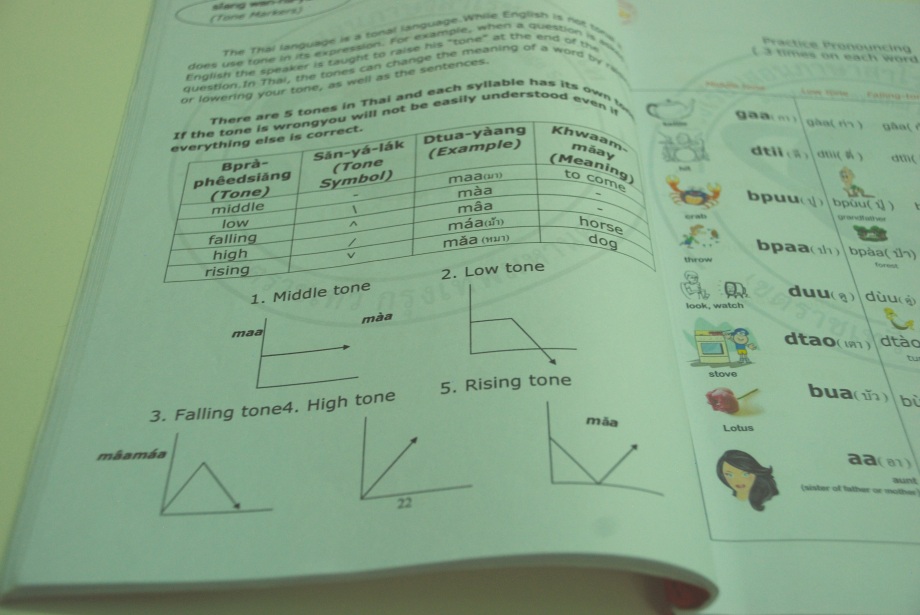Sà-wàt-dii-khráb!
We’re learning Thai! It’s fun, but also demanding. With all the language learning in my background, I’ve found that I’m able to fairly easily navigate through this 44 consonant, 28 vowel, 5 tone language. But Jessie frequently looks as if she’s ready to bash her head against the wall. Poor girl!
Part of the problem is we just don’t have enough time to study. Our course meets Monday, Wednesday and Friday afternoons, three hours each day. During those lessons we get a huge vat of vocabulary, grammar and idioms dumped upon us, desperately hoping that some of the words and nuances will seep into us while the great bulk of the deluge runs off our backs, down our pant legs and pools somewhere in the next room in a cacaphonous heap of accent markers. Then we go home, open our homework books along with our overflowing class notebooks and search for the necessary words and phrases to complete the lessons. We know the words are there; we remember writing them at some point during one of our classes, but somehow they manage to jump around and never land on the first or second or third page we scour.
I think the tones are the most infuriating part of the language. I don’t mean making the tones; that’s come easy enough. No, the problem is that one word can mean so many different things depending on how you say it. Take the word mai, which “usually” sounds like the English word my. Here are it’s meanings:
- mai [neutral tone] – silk
- mài [low tone] – new
- mǎi [rising tone] – burn
- mái [high tone] – used to make a statement into a question; also, it means wood
- mâi [falling tone] – no, not (used together with a verb)
So imagine my confusion when I go to the mall to buy a new (mài) shirt and twenty minutes later walk out looking like John Travolta in Saturday Night Fever (mai). Okay, I’m joking. But it really does make the language 50% harder to speak. The tones also make it hard to take the language seriously. No, honestly. Try speaking a few sentences in English but raise and lower your vocal tone every other word. See what I mean?
Okay, I’m nit-picking. Actually we’re really enjoying Thai when we get the chance to use it! I love the fact that when the landlady calls me over to talk to me at a rate of 200 words-per-minute I can now at least get the general subject and a ‘feeling’ of what she may be talking about. One of the easier things about Thai is that you don’t have to change any verbs to create past tense; instead they just have a few words that indicate the tense has switched. For example, we say “I eat rice” [phǒm gìn khâaw] but to make it a past action “I ate rice” you just add the word already to the end [phǒm gìn khâaw lέεw]. (Are you taking notes? There will be a quiz on this later!)
Also, we have a good teacher who goes by the mysterious name ‘A’ (pronounced like it’s a question…A?). He always talks about his friend Anna from Canada and how he continually makes her angry by accidentally saying the wrong things in English, like asking her “Are you boring?” instead of “Are you bored?” Every time I ask him in Thai how he’s doing, which is every class because that was the second thing we ever learned to say, he replies, “My heart is broken.” This is inevitably followed by some story of how yesterday he was walking down the street and saw someone he used to go out with and she was walking with another man. Yes. Every time. And he swears up and down that he never watches Thai dramas! I’m not convinced.
So we keep plugging away and unconfidently look ahead to days when we can hold our own in a Thai conversation. But until then, you have my permission to think about me sitting in a restaurant and sounding as awkward as a Russian trying to order quesadillas.



